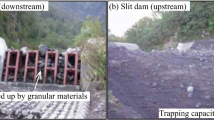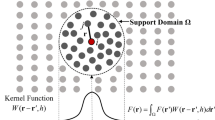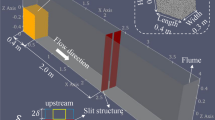Abstract
Slit-type barriers, one of open-type barriers, are widely used as active measures to mitigate potential risk and damage by debris flows, and those are designed and installed to reduce the flow energy by only passing relatively small debris. However, the mechanisms of slit-type barriers in reducing the debris flow velocity and debris volume remain poorly understood because of the lack of well-controlled and reliable physical modeling results. This study explored the influence of various arrangements of slit-type barriers, including P-type barriers in which each rectangular barrier was placed in parallel and V-type barriers where the barriers were placed in a V-shape, on characteristics of water-dominant debris flows via small-scale model experiments. The debris flow events were reproduced against the slit-type barriers, where the velocity reduction and trap ratio were monitored, varying the angle and shape of barrier arrangements. The velocity reduction and trap ratio appeared to increase as the angle of the barrier wall decreased because of the decreased opening ratio. The V-type barriers resulted in higher velocity reduction and trap ratio than the P-type, primarily because of the smaller effective opening ratio and the more backwater effect. In addition, as the debris contained more boulders, the extent of velocity reduction and debris trap became greater in all barrier types. Two types of opening ratios, the projected and effective opening ratios, were correlated to the interactions between debris and walls. The obtained results provide baseline data for the optimum design of slit-type barriers against debris flow and suggest that the slit-type barriers can effectively manage the risk of damage by debris flows.













Similar content being viewed by others
References
Armanini A, Larcher M, Odorizzi M (2011) Dynamic impact of a debris flow front against a vertical wall. 5th International conference on debris-flow hazards mitigation: mechanics, prediction and assessment, Padua, Italy, 14–17 June, pp 1041–1049
Choi CE, Ng CW, Au-Yeung SCH, Goodwin GR (2015) Froude characteristics of both dense granular and water flows in flume modelling. Landslides 12:1197–1206. doi:10.1007/s10346-015-0628-8
Cui P, Zeng C, Lei Y (2015) Experimental analysis on the impact force of viscous debris flow. Earth Surf Proc Land 40:1644–1655. doi:10.1002/esp.3744
Evans SG (1982) Landslides and surficial deposits in urban areas of British Columbia: a review. Can Geotech J 19:269–288
Gregoretti C (2000) The initiation of debris flow at high slopes: experimental results. J Hydraul Res 38:83–88. doi:10.1080/00221680009498343
Hübl J, Suda J, Proske D, Kaitna R, Scheidl C (2009) Debris flow impact estimation. 11th International symposium on water management and hydraulic engineering, Ohrid, Macedonia, 1–5 September, pp 1–5
Hungr O, Morgan G, Kellerhals R (1984) Quantitative analysis of debris torrent hazards for design of remedial measures. Can Geotech J 21:663–677
Ikeya H, Uehara S (1980) Experimental study about the sediment control of slit Sabo dams. J Jpn Erosion Control Eng Soc 114:37–44
Iverson RM (1997) The physics of debris flows. Rev Geophys 35:245–296
Jakob M, Hungr O, Jakob DM (2005) Debris-flow hazards and related phenomena. Springer, Berlin
Jeong S, Kim Y, Lee JK, Kim J (2015) The 27 July 2011 debris flows at Umyeonsan, Seoul, Korea. Landslides 12:799–813
Kim Y, Nakagawa H, Kawaike K, Zhang H (2013) Study on characteristic analysis of closed-type Sabo dam with a flap due to dynamic force of debris flow. Annuals of the Disaster Prevention Research Institute, Kyoto University, Japan
Lister D, Morgan G, Vandine D, Kerr J (1984) Debris torrents along Howe Sound, British Columbia. 4th International Symposium on Landslides, Toronto, Canada, pp 649–654
Nasmith H, Mercer A (1979) Design of dykes to protect against debris flows at Port Alice, British Columbia. Can Geotech J 16:748–757
Ng CW, Choi C, Song D, Kwan J, Koo R, Shiu H, Ho KK (2015) Physical modeling of baffles influence on landslide debris mobility. Landslides 12:1–18. doi:10.1007/s10346-014-0476-y
Pan HL, Huang JC, Wei LQ, Ou GQ (2012) A study on scouring laws downstream of debris flow Sabo dams. Appl Mech Mate 170–173:2071–2076
Pierson TC (2005) Hyperconcentrated flow―transitional process between water flow and debris flow. In: Jakob M, Hungr O (eds) Debris-flow hazards and related phenomena. Springer, Berlin, pp 159–202
Scheidl C, Chiari M, Kaitna R, Müllegger M, Krawtschuk A, Zimmermann T, Proske D (2013) Analysing debris-flow impact models, based on a small scale modelling approach. Surv Geophys 34:121–140
Scott KM, Vallance J, Pringle PT (1995) Sedimentology, behavior, and hazards of debris flows at Mount Rainier. USGS professional paper 1547, US Geological Survey
Sharpe CFS (1938) Landslides and related phenomena: a study of mass-movements of soil and rock. Columbia University Press, New York
Swanston DN, Swanson FJ (1976) Timber harvesting, mass erosion, and steepland forest geomorphology in the Pacific Northwest. Geomorphol Eng 4:199–221
Takahashi T (2014) Debris flow: mechanics, prediction and countermeasures. CRC, New York
Thielicke W, Stamhuis E (2010) Time resolved digital particle image velocimetry tool for Matlab. This code can be downloadable at the following website: http://PIVlab.blogspot.com
Watanabe M, Mizuyama T, Uehara S (1980) Review of debris flow countermeasure facilities. J Jpn Erosion Control Eng Soc 115:40–45
Wenbing H, Guoqiang O (2006) Efficiency of slit dam prevention against non-viscous debris flow. Wuhan Univ J Nat Sci 11:865–869. doi:10.1007/BF02830178
Zollinger F (1985) Debris detention basins in the European Alps. International symposium on erosion, debris flow and disaster prevention, Tsukuba, Japan, pp 433–438
Acknowledgements
This research was supported by a grant (13SCIPS04) from Smart Civil Infrastructure Research Program funded by the Ministry of Land, Infrastructure and Transport (MOLIT) of Korea government and Korea Agency for Infrastructure Technology Advancement (KAIA) and by the Basic Science Research Program through the National Research Foundation of Korea (NRF) funded by the Ministry of Science, ICT Future Planning (2014R1A1003419).
Author information
Authors and Affiliations
Corresponding author
Rights and permissions
About this article
Cite this article
Choi, SK., Lee, JM. & Kwon, TH. Effect of slit-type barrier on characteristics of water-dominant debris flows: small-scale physical modeling. Landslides 15, 111–122 (2018). https://doi.org/10.1007/s10346-017-0853-4
Received:
Accepted:
Published:
Issue Date:
DOI: https://doi.org/10.1007/s10346-017-0853-4




